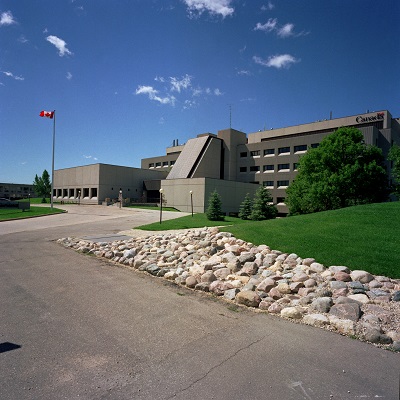Freshwater Institute
Recognized Federal Heritage Building
Winnipeg, Manitoba

Freshwater Institute
© Fisheries and Oceans Canada | Pêches et Océans Canada, 2016
Address :
501 University Crescent, Winnipeg, Manitoba
Recognition Statute:
Treasury Board Policy on Management of Real Property
Designation Date:
2019-06-06
Dates:
-
1972 to 1972
(Construction)
Custodian:
Fisheries and Oceans Canada
FHBRO Report Reference:
16-089
DFRP Number:
12563
Description of Historic Place
The Freshwater Institute houses the offices and laboratories of Fisheries and Oceans Canada. It is a large, raw concrete building in the Late Modern and Brutalist styles, consisting of several asymmetric interconnected volumes. A central foyer with a steeply pitched metal roof connects to a low three-storey wing on the left and a small cubic volume on the right. Behind these is a rectangular five-storey volume with a two-storey addition connected to the rear. The Freshwater Institute is an imposing, sculptural mass, with smooth and textured surfaces and carved out voids and strong volumes which create a dramatic sense of contrast and depth. The building sits on its lot, delineated by Dafoe Road and University Crescent, and the parking lot to the rear.
Heritage Value
The Freshwater Institute is a “Recognized” Federal Heritage Building because of its historical associations and architectural and environmental values.
Historical value:
The Freshwater Institute is a very good example of the development of freshwater and Arctic fisheries and aquatic ecosystems research in Canada in the second half of the 20th century when conservation and protection were growing federal priorities. It is the first purpose-built facility for advanced research in its domains, and represents this period’s increased federal priority on scientific research and public awareness of environmental issues. It is associated with several nationally and internationally significant scientists, including Dr. Dave Schindler, whose research led to the banning of phosphates in detergents, and Dr. Richard Beamish, who was awarded the Order of Canada for discoveries relating to acid rain and climate impacts on fish. The Institute is a very good example of the 1970s wave of development at the Fort Garry campus at the University of Manitoba, and provided the university with a cutting-edge research facility comparable to other Canadian academic institutions.
Architectural value:
The Freshwater Institute is a good example of Late Modern and Brutalist architectural styles, and a very good example of an institutional research facility. The H-shaped plan of the five-storey volume, with its long wings, allows the building to be adapted for users’ changing needs, while the integration of offices and laboratories along the same hallways creates efficiency and ease of use. The quality of craftsmanship and materials are good; it is clad in pre-fabricated concrete, with standard interior finishes typical of the period. The Freshwater Institute is a very good example of the late-career work of architectural firm Green, Blankstein, Russell. All graduates of the University of Manitoba, they designed several other significant buildings on the campus and across Canada. This structure illustrates their longstanding commitment to the development of Modernism in Canada.
Environmental value:
The layout of the building and its relationship to its campus lot has been maintained over the years, despite a few changes to the landscaping of the site, the removal of the George Norris-designed fountain from the entrance court, and reconfiguration of the main entrance. The Institute is compatible with the aesthetically diverse character of the western edge of the University of Manitoba campus. It is a conspicuous landmark for a range of communities and users: as the regional headquarters of Fisheries and Oceans Canada; as a centre of scientific research with national and international impact; as an example of the work of a significant architecture firm; and as a visual landmark which acts as a gateway to the campus, though this has been diminished by more recent construction.
Character-Defining Elements
The character-defining elements of the Freshwater Institute that should be respected include: Its functional design as a university and government research laboratory, shown by: its efficient layout with the integration of labs and offices along shared hallways; the repetition of internal organization on every floor; the H-shaped plan of the five-storey volume with its central service corridor; the use of standard materials to allow for ease of conversion and upgrades as needs arise.
Its Late Modern and Brutalist architectural styles, shown by: the imposing size of its grouping of irregular, varied masses; asymmetrical, interconnected volumes; a balance of voids and solids that produces dramatic contrasts of shadow and light; its tiered composition; the raw pre-cast and poured concrete in two finishes (high-relief vertical groove and smooth with exposed aggregate) that flows from exterior to interior spaces through continuity of materials; the use of carved concrete shapes; the large interior volume of the staircase lobby.
Its connection to the work of the nationally significant architecture firm of Green, Blankstein, Russell, and artist Tony Tascona, shown by: the minimal ornamentation, glass walls, simple volumes, regular grids, and emphasis on functionality and efficiency its design, which represents a very strong example of the late-career work of Green, Blankstein, Russell; Tascona’s dynamic sculpture Drops of Pond Water suspended over the atrium staircase which highlights the Institute’s focus on science and water.
Its institutional layout and relationship to its site, shown by: its simple landscape design, which includes open grassy areas, round-topped berms, scattered random plantings, a courtyard, and large entryway at the front.